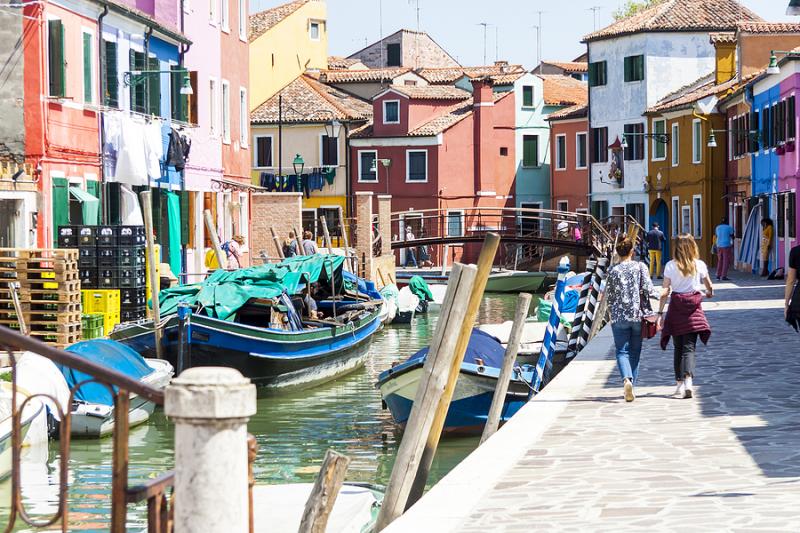Most tourists in Venice, if they venture out to the islands, take the vaporetto number 12 from San Zaccaria or Fondamenta Nuova to Murano, the ‘glass island’ where the furnaces for the famous Venetian glass are still in use. The onward journey to Burano takes a further 25 minutes, and in the heat of summer the sea breezes are a bonus.
Even on the dullest day, seeing Burano in the distance is quite a shock. You see a lively patchwork of small houses, every one a different colour. Some clash with their neighbours, some provide harmonious contrasts, but all merge into a kaleidoscope of glistening multi-coloured fragments reflected in the sea. It is the most attractive approach to an island anywhere in the Adriatic.

Tradition has it that the colours originate from times when the fishermen were often out in winter, when fog blanketed the Lagoon, and needed to be able to recognise their homes out of the gloom. It’s also said that their fishing boats had coloured sails to match their houses, so that their wives could identify their own boat’s return.
Certainly, the mists and swirling fog in this part of the Lagoon, known as Venezia Nativa, acted in the past as a natural defence for its inhabitants who settled there after fleeing invasions from Lombardians. The low tides and deeper underwater channels also helped to protect the island which became home to one of the largest salt marsh populations of the Adriatic. Now, the three islands of Burano, Mazzorbo and Torcello combined have a population of less than 3,000.
The approach to Burano follows the Mazzorbo Canal where this island is linked to Burano by a wooden bridge, and when you alight, there isn’t much choice of routes to follow, wandering along via A. Marcello and passing several women sitting in doorways with their lace pillows and bobbins, making the lace for which Burano is (or was) famous. Originally it was a pastime for noble women, which spread to hospitals and institutions where women were obliged to take up the occupation. Later there was competition from French lace makers, so much so that the Venetian authorities granted preferential privileges, but demand dwindled so that by the 19th century there were only two lace factories left and lace-making reverted to being a private domestic occupation. A lace-making school was established in 1872, and the Museo del Consortio Merletti di Burano in the main square houses an important collection of collars, parasols, bedspreads, handkerchiefs and lace decorations.

An attractive legend explains how lace-making came to be an important occupation on the island. It’s said that the delicate white patterns were inspired by the swish of a mermaid’s tail in the waves.
San Martino church in Piazza Baldassare Galuppi is the focus of another intriguing legend. From the outside it’s rather ordinary, apart from the eye-catching 18th century campanile which leans 1m 85 from the vertical. Lots of visitors stop in the piazza to photograph this leaning tower, but by some feat of modern design with phones and cameras, the image is annoyingly often straightened and corrected. The church houses an important painting of a crucifixion by Tiepolo, but also a remarkable huge sarcophagus, the source of Burano’s miracle. The story is that this heavy stone sarcophagus was washed up on the shores of Burano, but it was too heavy for anyone to be able to drag it up the beach. Eventually a group of children came along and they were helped to move it by the intervention of the three saints (Alban, Dominic and Orso) whose remains were inside it. This miracle is illustrated by a large painting inside the church, The Miracle of the Children and the Urn, known in Italian as ‘Il Miracolo dei Ragazzi che Traggono a Terra il Sarcofago’ by Alessandro Zanchi, painted in 1690.

These same three saints are also believed to have saved Burano from the Plague in 1670 by their divine intervention. Their revered skeletons are now resting in the altar below the sarcophagus.
Most tourists are completely unaware of the stories linked with the island. They come to wander the multi-coloured streets and have lunch in one of the many tempting trattorie, the most famous of which is the Trattoria Al Gatto Nero.

The Black Cat is an institution in Burano. It was established in 1946, and has been owned and run by the same family since 1965, one of those traditional places where paintings cover the walls, Murano glass chandeliers hang from the ceilings, and the smart staff formally dressed in black contrast with the sparkling white tablecloths, attending both to local regulars and passing visitors with the same courtesy and attention to detail. Mostly, the tourists seem to choose tables outside, but the interior is cooler and has much more character, and you get the bonus of the maestro chef Ruggero Bovo, emerging from the kitchen to ensure that all his customers are satisfied with his creations.
The menu is entirely fish – what else? – and what a choice there is! Probably every living creature in the Mediterranean is on the menu here. There are steaming piles of crustaceans on every table, or grilled whole fish being expertly boned in front of their diners.
Whether your taste in legends runs from the charming (lace inspired by mermaids) to the highly improbable (heavy sarcophagus full of saints), the fanciful (coloured houses and boat sails) or to gourmet miracles, Burano has everything to satisfy the most jaded tourist who will leave with spirits lifted, and a belief in magic.














